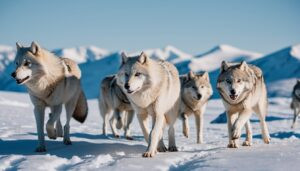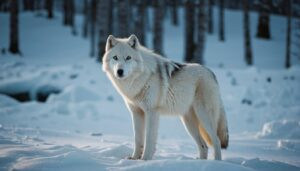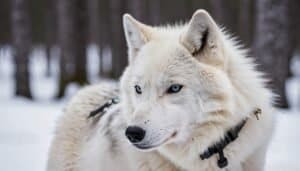Introduction
Disease outbreaks significantly impact Arctic wolf populations, affecting their health, behavior, and survival
This article explores common diseases that afflict these wolves, how diseases spread, and the symptoms and behavioral changes they cause. We will examine the mortality rates and reproductive success during outbreaks, the influence of climate change, and the methods used to monitor and prevent these diseases
Understanding these aspects is crucial for the conservation and management of Arctic wolf populations in their harsh, changing environment
Common Diseases Affecting Arctic Wolf Populations
Disease outbreaks are a critical factor influencing Arctic wolf populations. These majestic creatures, adapted to survive in one of the harshest environments on Earth, are susceptible to various diseases that can devastate their numbers
Understanding the common diseases affecting Arctic wolves is essential for conservation efforts and ensuring their survival. This section explores viral, bacterial, and parasitic infections that commonly impact Arctic wolves
Viral Infections
Viral infections are a significant threat to Arctic wolf populations
One of the most concerning viral diseases is canine distemper. Canine distemper virus (CDV) affects the respiratory, gastrointestinal, and central nervous systems of infected animals. It spreads through direct contact with bodily fluids or contaminated environments, making it highly contagious among wolf packs
In 2016, an outbreak of canine distemper in the Arctic regions of Canada significantly impacted local wolf populations. Studies showed that infected wolves exhibited symptoms such as fever, nasal discharge, coughing, and neurological signs like seizures and paralysis (Government of Northwest Territories, 2017). The mortality rate during this outbreak was alarmingly high, leading to a notable decline in wolf numbers in the affected areas
Another viral disease of concern is rabies. Rabies is a fatal zoonotic disease caused by the rabies virus, which affects the central nervous system. It is transmitted through the saliva of infected animals, usually via bites
Arctic wolves, often interacting with other wildlife like foxes and bats, are at risk of contracting rabies. Infected wolves exhibit aggressive behavior, excessive salivation, and paralysis before succumbing to the disease. Rabies outbreaks can lead to significant mortality in wolf populations and pose a threat to other wildlife and humans
Bacterial Infections
Bacterial infections also pose a considerable threat to Arctic wolves
One notable bacterial disease is tularemia, caused by the bacterium Francisella tularensis. Tularemia affects various animal species, including wolves, and can be transmitted through contaminated water, soil, or infected prey. Symptoms in wolves include fever, lethargy, loss of appetite, and swollen lymph nodes
In 2015, an outbreak of tularemia was documented in the Arctic regions of Alaska. Researchers found that the disease significantly impacted wolf populations, reducing their numbers due to high mortality rates (U.S. Geological Survey, 2016). The study highlighted the need for monitoring and managing bacterial diseases in Arctic wildlife to prevent such outbreaks
Leptospirosis is another bacterial infection affecting Arctic wolves. Caused by the bacterium Leptospira, this disease spreads through contact with contaminated water or soil
Infected wolves may exhibit symptoms such as fever, vomiting, diarrhea, and kidney or liver failure. Leptospirosis can lead to severe health complications and mortality, impacting the overall health and population dynamics of Arctic wolves
Parasitic Infections
Parasitic infections are common among Arctic wolves, primarily due to their interactions with prey and the environment
One of the most prevalent parasitic diseases is sarcoptic mange, caused by the Sarcoptes scabiei mite. Mange leads to intense itching, hair loss, and skin lesions in infected wolves. Severe infestations can result in secondary infections and death due to weakened immunity and poor body condition
In recent years, sarcoptic mange outbreaks have been reported in Arctic wolf populations across Canada and Alaska. These outbreaks have caused significant declines in wolf numbers, highlighting the impact of parasitic infections on their survival (Canadian Cooperative Wildlife Health Centre, 2018)
Another common parasitic infection is echinococcosis, caused by the tapeworm Echinococcus granulosus
This parasite forms cysts in the internal organs of infected wolves, leading to severe health issues and potentially fatal outcomes. Arctic wolves contract echinococcosis by consuming infected prey, such as caribou and rodents. Managing prey populations and implementing deworming programs are crucial for controlling this parasitic disease
Spread of Diseases Among Arctic Wolves
The spread of diseases among Arctic wolves is influenced by several factors, including transmission methods, environmental conditions, and interactions with other species. Understanding how these factors contribute to the spread of diseases is crucial for developing effective management and prevention strategies to protect Arctic wolf populations
Transmission Methods
Diseases among Arctic wolves can be transmitted through various methods, including direct contact, ingestion of contaminated food or water, and vector-borne transmission
Direct contact is one of the most common transmission methods, especially for diseases like canine distemper and rabies. Infected wolves can spread these diseases through saliva, urine, or feces, leading to rapid transmission within a pack
For example, rabies can be transmitted through bites from infected animals, such as foxes or other wolves. Once a wolf is infected, it can spread the virus to other members of its pack through aggressive interactions or grooming behaviors
Similarly, canine distemper spreads through respiratory secretions, making it highly contagious in close-knit wolf packs where physical contact is frequent
Ingestion of contaminated food or water is another significant transmission method. Wolves can contract diseases like tularemia and leptospirosis by consuming infected prey or drinking from contaminated water sources. In regions where prey populations are affected by disease, wolves are at a higher risk of infection, leading to outbreaks within their populations
Vector-borne transmission involves diseases spread by insects or other organisms that carry pathogens from one host to another. For instance, Arctic wolves can contract Lyme disease through tick bites
The bacteria responsible for Lyme disease, Borrelia burgdorferi, is transmitted by ticks that infest the wolves’ fur. Vector-borne diseases are particularly concerning in the Arctic, where climate change is altering the distribution and activity of disease vectors like ticks and mosquitoes
Environmental Factors
Environmental factors play a crucial role in the spread of diseases among Arctic wolves
The harsh Arctic environment, characterized by extreme cold, seasonal variations, and limited food resources, can exacerbate the impact of diseases on wolf populations. During harsh winters, weakened wolves are more susceptible to infections due to malnutrition and stress
Seasonal changes also influence disease dynamics. In the summer, when prey abundance is higher, wolves may come into contact with infected animals more frequently. Conversely, in the winter, when prey is scarce, wolves may scavenge for food, increasing the risk of ingesting pathogens from carcasses
Climate change is another significant environmental factor affecting disease spread. Warming temperatures are altering the Arctic ecosystem, leading to changes in the distribution and abundance of disease vectors and hosts. For example, milder winters and longer summers can increase the survival and activity of ticks, thereby enhancing the transmission of tick-borne diseases like Lyme disease
Interaction with Other Species
Arctic wolves interact with various other species in their ecosystem, including prey animals, scavengers, and other predators. These interactions can facilitate the spread of diseases. For instance, wolves that hunt and consume infected caribou or rodents are at risk of contracting diseases like echinococcosis and tularemia
Interactions with scavengers, such as foxes and birds, can also contribute to disease transmission
Scavengers often feed on the same carcasses as wolves, potentially spreading pathogens through their feces or saliva. Additionally, Arctic wolves occasionally come into contact with domestic dogs and other wildlife that can serve as reservoirs for diseases like canine distemper and rabies
Human activities, such as hunting and wildlife management, can further influence disease spread. For example, translocating wildlife for conservation purposes or using bait to attract animals can inadvertently introduce pathogens into new areas, affecting local wolf populations
Symptoms and Impact on Behavior
Diseases significantly affect the physical health and behavior of Arctic wolves. Recognizing the symptoms of various diseases and understanding their impact on behavior is essential for early detection and effective management
This section delves into the physical symptoms, behavioral changes, and case studies illustrating how diseases influence Arctic wolf populations
Physical Symptoms
The physical symptoms of diseases in Arctic wolves vary depending on the type of infection
However, some common signs can help identify sick wolves:
Canine Distemper: Wolves infected with canine distemper virus (CDV) may exhibit symptoms such as high fever, nasal and eye discharge, coughing, lethargy, and loss of appetite. As the disease progresses, neurological signs like seizures, muscle tremors, and paralysis can develop, often leading to death
Rabies: Rabies in Arctic wolves presents initially as behavioral changes, progressing to more severe symptoms such as excessive salivation, difficulty swallowing, and aggression. The disease rapidly affects the central nervous system, leading to paralysis and death within days of symptom onset
Tularemia: Symptoms of tularemia in wolves include fever, swollen lymph nodes, and lethargy. In severe cases, infected wolves may experience difficulty breathing and liver or spleen enlargement
Leptospirosis: Wolves with leptospirosis may show signs of fever, muscle pain, vomiting, diarrhea, and jaundice (yellowing of the skin and eyes). Severe cases can result in kidney or liver failure, which can be fatal
Sarcoptic Mange: Sarcoptic mange causes intense itching, hair loss, and thickened skin with crusty lesions. Affected wolves may develop secondary infections due to constant scratching and open sores
Echinococcosis: This parasitic infection leads to the formation of cysts in the internal organs, causing symptoms like weight loss, abdominal pain, and respiratory distress if the lungs are affected
Behavioral Changes
Diseases not only cause physical symptoms but also lead to significant behavioral changes in Arctic wolves. These changes can affect their ability to hunt, reproduce, and interact within their social structures:
Canine Distemper: Wolves with distemper often become lethargic and less active. The neurological symptoms can lead to disorientation, making it difficult for them to hunt and evade predators
Rabies: Rabid wolves display heightened aggression and uncharacteristic fearlessness, increasing the risk of attacks on other animals and humans. As the disease progresses, they may exhibit confusion and aimless wandering
Tularemia and Leptospirosis: Infected wolves with these bacterial diseases may become more reclusive, avoiding interaction with their pack. Their reduced activity levels and weakened state can impair hunting efficiency
Sarcoptic Mange: Wolves suffering from mange may isolate themselves due to severe itching and discomfort. This isolation can disrupt pack dynamics and reduce cooperative hunting efforts
Echinococcosis: Infected wolves may show decreased stamina and activity levels due to the cysts affecting their internal organs. This decrease in physical capability can impact their ability to chase and capture prey
Case Studies
Several case studies highlight the impact of diseases on Arctic wolf populations:
Canine Distemper in Northern Canada (2016): During a significant outbreak, researchers observed a sharp decline in the wolf population due to high mortality rates
The affected wolves displayed severe neurological symptoms, and many succumbed to the disease. This outbreak underscored the vulnerability of isolated wolf populations to highly contagious diseases (Government of Northwest Territories, 2017)
Rabies in Alaska (2014): A rabies outbreak in Alaska led to aggressive behavior and increased human-wildlife conflicts
The infected wolves displayed classic rabies symptoms, including aggression and paralysis. Public health measures were implemented to prevent the spread of the disease to other wildlife and humans (Alaska Department of Fish and Game, 2015)
Sarcoptic Mange in Canada (2018): An outbreak of sarcoptic mange severely affected Arctic wolf populations in Canada
Infected wolves experienced intense itching and hair loss, leading to secondary infections and death in severe cases. The outbreak highlighted the need for monitoring and managing parasitic diseases in wolf populations (Canadian Cooperative Wildlife Health Centre, 2018)
Mortality and Reproductive Success
Disease outbreaks among Arctic wolves have profound effects on their mortality rates and reproductive success. The survival and population dynamics of these wolves can be significantly impacted by disease-related deaths and reduced breeding success
This section examines the mortality rates during disease outbreaks, their impact on breeding, and the broader implications for population dynamics
Mortality Rates
Mortality rates among Arctic wolves can vary widely depending on the disease and the severity of the outbreak:
Canine Distemper: Canine distemper is known for its high mortality rate, particularly in younger wolves and those with weakened immune systems
During the 2016 outbreak in Northern Canada, the mortality rate in some wolf packs was estimated to be as high as 50-70% (Government of Northwest Territories, 2017). The virus’s impact on the central nervous system often leads to death, especially if the wolves do not receive timely medical intervention
Rabies: Rabies is almost invariably fatal once clinical symptoms appear. The mortality rate for rabies in wolves is nearly 100%, as there is no cure for the disease once neurological symptoms develop. Infected wolves typically die within 10 days of symptom onset (Alaska Department of Fish and Game, 2015)
Tularemia and Leptospirosis: These bacterial diseases also contribute to significant mortality rates. In severe outbreaks, tularemia and leptospirosis can lead to death due to organ failure or secondary infections. Mortality rates can vary but are often high in untreated populations
Sarcoptic Mange: Sarcoptic mange itself may not always be fatal, but severe cases can lead to death due to secondary infections and weakened health. Mortality rates in mange outbreaks depend on the extent of the infestation and the overall health of the wolf population (Canadian Cooperative Wildlife Health Centre, 2018)
Echinococcosis: While not always immediately fatal, echinococcosis can cause long-term health issues that lead to death if left untreated. The presence of cysts in vital organs like the liver and lungs can severely impair the wolves’ health and lifespan
Impact on Breeding
Disease outbreaks can significantly affect the reproductive success of Arctic wolves:
Canine Distemper: Wolves recovering from distemper may experience long-term health issues that impact their reproductive capabilities. Female wolves may have reduced fertility, and surviving pups may have lower survival rates due to weakened health and immunity
Rabies: Since rabies is almost always fatal, infected wolves do not have the opportunity to breed. Outbreaks can decimate entire packs, eliminating potential breeders and disrupting pack social structures necessary for successful reproduction
Tularemia and Leptospirosis: These diseases can affect the reproductive organs and overall health of wolves, leading to reduced fertility and higher rates of miscarriages or stillbirths. Infected females may have lower litter sizes and higher pup mortality rates
Sarcoptic Mange: Wolves suffering from severe mange are often in poor physical condition, making it difficult for them to reproduce successfully. The stress and energy expenditure associated with constant itching and secondary infections can reduce reproductive success
Echinococcosis: The presence of parasitic cysts can affect the overall health and reproductive capabilities of wolves. Infected wolves may have reduced fertility and may be less likely to successfully raise their pups
Population Dynamics
The impact of disease outbreaks on mortality and reproductive success can lead to significant changes in Arctic wolf population dynamics:
Reduced Pack Sizes: High mortality rates and decreased reproductive success can lead to smaller pack sizes. Smaller packs may struggle to hunt effectively, impacting their ability to secure enough food and survive harsh Arctic conditions
Disrupted Social Structures: Disease outbreaks can disrupt the social structures of wolf packs. The loss of key individuals, such as alpha males and females, can lead to instability and challenges in maintaining pack cohesion and leadership
Genetic Bottlenecks: Repeated disease outbreaks can lead to genetic bottlenecks, reducing genetic diversity within the population. Lower genetic diversity can make the population more susceptible to future disease outbreaks and other environmental challenges
Long-Term Population Decline: Severe and frequent disease outbreaks can lead to long-term population declines. If wolf populations cannot recover quickly enough, they may face the risk of local extinctions in certain areas
Climate Change and Disease Outbreaks
Climate change is increasingly affecting ecosystems worldwide, and the Arctic is no exception. Rising temperatures and changing environmental conditions have significant implications for disease dynamics among Arctic wolf populations
This section explores the influence of warming temperatures on disease outbreaks, changes in disease patterns, and future projections for Arctic wolf health
Influence of Warming Temperatures
Warming temperatures in the Arctic are leading to profound changes in the region’s ecosystems. These changes can influence the prevalence and transmission of diseases among Arctic wolves in several ways:
Extended Vector Seasons: Warmer temperatures extend the active seasons of vectors such as ticks and mosquitoes, which can carry and transmit diseases
For instance, the longer tick season increases the likelihood of Lyme disease transmission. Studies have shown that tick populations are expanding northward, increasing the risk of infection for Arctic wolves (Ogden et al., 2014)
Altered Prey Populations: Climate change can affect the abundance and distribution of prey species, which in turn impacts Arctic wolves
Changes in prey availability can force wolves to hunt different species, potentially exposing them to new pathogens. For example, fluctuations in rodent populations due to climate variability can influence the prevalence of tularemia, a disease transmitted by rodents
Thawing Permafrost: Thawing permafrost can release dormant pathogens, potentially introducing new diseases to Arctic wildlife. For example, anthrax spores, which can survive in frozen soil for decades, may be released as the permafrost melts, posing a threat to wolves and other animals (Revich et al., 2012)
Changes in Disease Patterns
Climate change is altering the patterns of disease outbreaks in the Arctic, with several notable trends:
Increased Frequency and Intensity of Outbreaks: Rising temperatures and changing environmental conditions can lead to more frequent and severe disease outbreaks. For example, the incidence of sarcoptic mange has increased in recent years, with warmer conditions favoring the survival and spread of mites (Canadian Cooperative Wildlife Health Centre, 2018)
Emergence of New Diseases: Changing climatic conditions can facilitate the emergence of new diseases that previously did not affect Arctic wolves. As ecosystems shift, wolves may come into contact with new pathogens and vectors, leading to novel disease challenges
Expanded Geographic Range of Diseases: Warming temperatures enable pathogens and vectors to expand their geographic range. Diseases once confined to lower latitudes are now appearing in the Arctic, posing new risks to wolf populations. For instance, the northward expansion of ticks has introduced Lyme disease to regions where it was previously absent (Ogden et al., 2014)
Future Projections
The future health of Arctic wolf populations is closely linked to ongoing climate change
Projections suggest several potential scenarios:
Increased Disease Burden: As temperatures continue to rise, Arctic wolves are likely to face an increased burden of diseases. The combination of extended vector seasons, emerging diseases, and shifting prey dynamics will pose significant challenges to wolf populations
Adaptation and Resilience: Wolves may adapt to changing conditions through behavioral and physiological changes. However, the rapid pace of climate change may outstrip their ability to adapt, leading to population declines. Conservation efforts will need to focus on enhancing the resilience of wolf populations through habitat protection and disease management
Collaborative Research and Monitoring: Addressing the impacts of climate change on Arctic wolves will require collaborative research and monitoring efforts. Scientists must track changes in disease dynamics, vector populations, and wolf health to develop effective mitigation strategies. Integrating traditional ecological knowledge from Indigenous communities with scientific research can provide valuable insights into the changing Arctic environment
Monitoring and Prevention
Effective monitoring and prevention strategies are crucial for managing disease outbreaks among Arctic wolf populations
This section explores various techniques used to monitor wolf health, preventive measures to protect them from diseases, and the role of conservation efforts in ensuring the long-term survival of these iconic predators
Monitoring Techniques
Monitoring the health of Arctic wolves involves a combination of fieldwork, laboratory analysis, and technology
Several techniques are used to track disease prevalence and assess wolf health:
Field Observations: Field biologists and researchers regularly observe wolf packs to identify signs of disease. Symptoms such as lethargy, coughing, skin lesions, and abnormal behavior can indicate the presence of infection. Direct observation helps in early detection and provides valuable data on disease spread and impact
Radio Collar Tracking: Radio collars equipped with GPS tracking allow researchers to monitor the movements and behavior of individual wolves. Tracking data can reveal changes in activity patterns that may be associated with disease, such as reduced movement or changes in territory use. Collared wolves can also be located more easily for physical health assessments
Sample Collection: Collecting biological samples from wolves, including blood, feces, and tissue samples, is essential for diagnosing diseases. Samples are analyzed in laboratories to detect pathogens, measure immune responses, and identify nutritional deficiencies. This information helps in understanding the prevalence and impact of diseases
Remote Sensing: Advances in technology have enabled the use of remote sensing tools, such as drones and satellite imagery, to monitor wolf populations and their environment. These tools can assess habitat changes, prey availability, and environmental conditions that may influence disease dynamics. Remote sensing provides a broader perspective on factors affecting wolf health
Camera Traps: Camera traps strategically placed in wolf habitats capture images and videos of wolves, providing insights into their behavior and physical condition. These non-invasive tools help monitor wolf populations without disturbing them and can reveal signs of disease, such as mange or emaciation
Preventive Measures
Preventing disease outbreaks among Arctic wolves involves a combination of proactive strategies aimed at reducing infection risk and enhancing overall health:
Vaccination Programs: Implementing vaccination programs for diseases like rabies and canine distemper can protect wolf populations from devastating outbreaks. Vaccinating domestic dogs in and around wolf habitats is also essential, as they can serve as disease reservoirs
Deworming Programs: Regular deworming of wolves, especially in areas where parasitic infections are prevalent, can help control diseases like echinococcosis and sarcoptic mange. Deworming baits can be distributed in wolf territories to reduce parasite loads
Habitat Protection: Protecting and preserving wolf habitats ensures that wolves have access to adequate prey and resources, reducing stress and vulnerability to diseases. Conserving large, contiguous areas of wilderness minimizes human-wildlife interactions that can introduce new pathogens
Prey Management: Managing prey populations to maintain a balanced ecosystem is crucial for wolf health. Overpopulation of certain prey species can lead to increased transmission of diseases like tularemia. Sustainable hunting practices and habitat management can help regulate prey populations
Minimizing Human Impact: Reducing human activities that can introduce diseases into wolf habitats is essential. This includes regulating tourism, minimizing waste that attracts scavengers, and controlling the movement of domestic animals in and out of wolf territories
Role of Conservation Efforts
Conservation efforts play a vital role in ensuring the long-term survival of Arctic wolf populations. These efforts encompass research, community engagement, and policy implementation:
Research and Collaboration: Ongoing research on Arctic wolf health and disease dynamics is essential for developing effective management strategies. Collaboration between wildlife biologists, veterinarians, ecologists, and Indigenous communities enhances the understanding of disease impacts and promotes holistic conservation approaches
Community Engagement: Engaging local communities, including Indigenous peoples, in conservation efforts is crucial. Indigenous knowledge and practices can provide valuable insights into wolf behavior, health, and environmental changes. Community involvement fosters a sense of stewardship and supports conservation initiatives
Policy and Regulation: Implementing and enforcing policies that protect wolf habitats and regulate human activities is fundamental. Policies that address climate change, habitat preservation, and wildlife health are necessary to mitigate the impacts of disease outbreaks. Conservation organizations and governments must work together to create and uphold these regulations
Public Awareness: Raising public awareness about the importance of Arctic wolves and the threats they face from diseases and climate change can garner support for conservation efforts. Educational campaigns and outreach programs can inform the public and encourage responsible behaviors that protect wolf populations
Conclusion
Disease outbreaks pose significant threats to Arctic wolf populations, affecting their health, behavior, mortality rates, and reproductive success. These outbreaks are influenced by various factors, including direct transmission methods, environmental conditions, and interactions with other species
Climate change exacerbates these threats by altering disease dynamics, extending vector seasons, and introducing new pathogens to the Arctic ecosystem. Effective monitoring techniques, such as field observations, radio collar tracking, sample collection, and remote sensing, are essential for early detection and management of diseases
Preventive measures, including vaccination programs, deworming, habitat protection, and minimizing human impact, are critical for reducing infection risks and enhancing the overall health of wolf populations. Conservation efforts that involve research, community engagement, policy implementation, and public awareness play a vital role in safeguarding the future of Arctic wolves
By understanding and addressing the complex factors influencing disease outbreaks, we can develop comprehensive strategies to protect these iconic predators and ensure their survival in a rapidly changing environment










